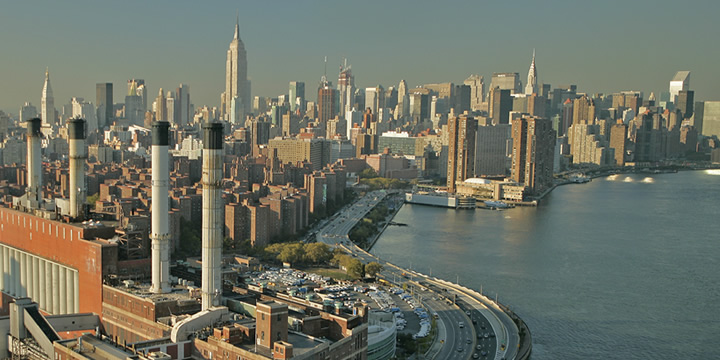Air Emissions Performance

Greenhouse gases are reported using carbon dioxide equivalents, or CO2e, a standardized unit designed to account for the differing warming potentials of the various greenhouse gases. In 2012, Con Edison’s direct greenhouse gas emissions decreased more than two percent from 2011, and 45 percent from baseline 2005 emissions. Con Edison of New York’s steam and cogeneration stations are the company’s largest sources of CO2 emissions, which are heavily influenced by energy demand and weather.
Con Edison, Inc. Greenhouse Gas Emissions
(thousands of tons CO2e)
Breakdown of 2012 Greenhouse Gas Emissions
(thousands of tons CO2e)
- CH4
- 320 8.9%
- CO2
- 3,053 85.3%
- SF6
- 208 5.8%
In 2012, the primary source of emissions reduction came through an increased proportion of cogeneration units and an increased gas use across our generating stations overall. Con Edison of New York uses cogeneration technology at its East River Plant in Manhattan for efficient energy production. Cogeneration uses the combustion of natural gas to produce both steam and electricity, effectively lowering the emission rate and improving the efficiency of our steam and electric systems. Our plants consumed close to 92 percent natural gas in 2012, up from 86 percent in 2011, and the company is heading towards having the capability to burn gas at additional steam generation plants by the end of the decade. Gas is cleaner than the #6 fuel oil that currently makes up eight percent of the total fuel burned at our steam plants. Con Edison of New York’s steam stations burn low-sulfur fuel oil to reduce SO2 emissions.
Con Edison’s vehicle fleet contributes a minute amount (approximately one percent) of total CO2 emissions. We continue to reduce emissions by using biodiesel fuel, as well as expanding the number of hybrid and alternative fuel vehicles. Currently, roughly half of our vehicle fleet is running on some form of alternative fuel or high-efficiency engine.
Methane is a greenhouse gas that has 21 times the heat-trapping potential of CO2. Fugitive methane emissions originate from Con Edison of New York’s and Orange and Rockland’s natural gas distribution systems. An ongoing program of infrastructure upgrades to the gas-delivery systems of our regulated utilities has contributed to an estimated 15 percent reduction in methane emissions since 1993. Principally through enhanced inspections and maintenance of gas infrastructure, proactive pipe replacement programs, lowered system gas pressures, and increased reclamation of gas left in pipes prior to servicing, Con Edison of New York has consistently made progress in reducing fugitive methane emissions.
Con Edison, Inc. CO2 Emission Trends
(thousands of tons)
Con Edison, Inc. Estimated CH4 Emission Trends
(thousands of tons CO2e)
Con Edison, Inc. SF6 Emission Trends
(thousands of tons CO2e)
In 2012, Con Edison completed its 19th year of participation in the U.S. EPA’s Gas Star program, a voluntary agreement to reduce natural gas emissions by implementing the program’s management practices.
In 1999, Con Edison entered into a memorandum of understanding with the EPA, voluntarily agreeing to reduce its emissions of sulfur hexafluoride (SF6), a colorless, odorless gas used in high-voltage circuit breakers and switches found chiefly in utility substations. Con Edison reduced its SF6 emissions by more than 91 percent between 1999 and 2012 through an aggressive equipment replacement and leak detection program, and employee training. Con Edison developed a work-management database to identify and prioritize leak-prone equipment in the system. The company has already surpassed its goal to reduce its emissions below 25,000 pounds of SF6 by 2020, and has instituted a new goal to reduce SF6 emissions an additional 25 percent by 2017.
